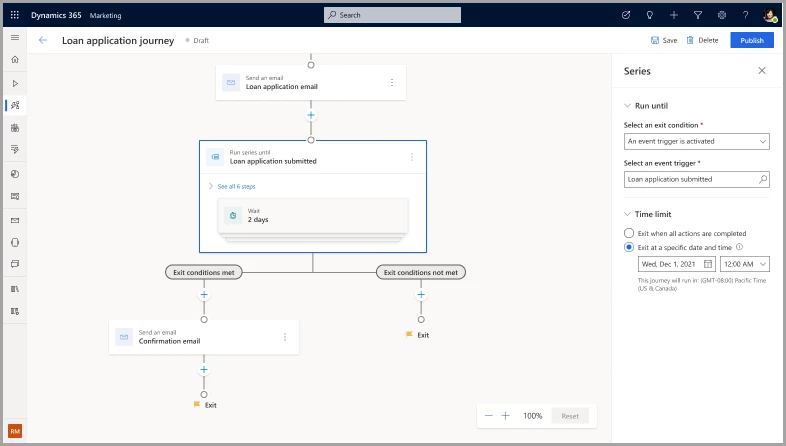
Customer journey orchestration levels up with advanced tools in Dynamics 365 Marketing
This article is contributed. See the original author and article here.
Marketers design customer journeys to provide the right message at the right time for customers to take the next step. With more opportunities than ever for interaction, you must take care not to overwhelm customers with unwanted messages. That’s why we’re delighted to introduce advanced real-time customer journey orchestration tools in Dynamics 365 Marketing that help you engage customers at key moments without bombarding them with spam.
Engage the right audience effortlessly with the new segment builder
Targeting the right audience is critical for creating highly personalized marketing campaigns that yield high conversion rates and improve engagement. Previously, the segment builder in Dynamics 365 Marketing required a deep understanding of database schemas. The new real-time segment builder in customer journey orchestration is marketer friendly. Easily reach customers through segmenting on demographic, firmographic, and behavioral data.
Here are some of the benefits of the new real-time marketing segment builder:
- It’s powered by artificial intelligence. Just describe, in plain English, how you’d like to create the segment, then review and use it.
- There’s no need to memorize relationships between tables. The builder automatically populates all the possible paths between customer profiles and the selected data table for you.
- View segment size and membership estimates before publishing.
- Enjoy a consistent creation experience between static and dynamic segments.
- Include or exclude individual members.
- Query segments based on their customer data in a consistent manner, without having to worry about which segment type to choose first.
- Adjust segment refresh frequency after publication.

Test your journey triggers to provide seamless experiences
Customers expect consistent and uninterrupted experiences in their interactions with brands. With custom trigger testing, marketers can simulate a customer’s experience, using themselves as a test subject. They can evaluate the journey based on the attributes defined in the custom trigger to identify and address issues before they affect real customers.

Boost your productivity when sending journey reminders
To improve the effectiveness of your marketing campaigns, it’s crucial to remind customers to take action on key tasks such as filling out a registration form or completing a purchase.
With enhanced real-time customer journey orchestration, it’s easy to set up recurring reminders to streamline the process of moving customers down the funnel. The reminder feature allows sending emails, text messages, and push notifications to increase engagement chances, instead of simply repeating the same marketing messages in the same channels. You can even set the number of repetitions or a time limit to make sure that messages aren’t sent indefinitely.
Track the customer’s exit from the reminder loop, too. By capturing different branches separately, such as cart checked out, cart not checked out, and cart expired, you can target and follow up with each segment appropriately.

Optimize customer engagement by controlling the number of messages sent
Consumers’ mailboxes are overflowing. Marketers must be careful not to overwhelm their customers with email, which can result in lower message engagement rates, increased unsubscribe rates, spam reports, or important messages being missed. With frequency capping, you can optimize engagement by controlling how many messages are sent.
Frequency capping allows marketers to define the maximum number of messages their customers receive through a particular channel per day, week, and month. Transactional messages are always excluded, and individual journeys can be left out of the cap so that important messages can be received. You can view whether a message was blocked by the frequency cap and for which users.
By monitoring engagement rates with marketing messages, you can fine-tune your message frequency. You’ll make sure that you’re striking the right balance between keeping the brand top-of-mind and overwhelming customers with too many messages.

Deliver personalized experiences at scale with advanced customer journey orchestration tools
Real-time journey orchestration now has interactions capabilities to deliver personalized experiences at scale. Reach up to 100 million contacts and deliver up to 300 million monthly interactions through email, text messages, push notifications, or custom channels, and create segments of up to 30 million contacts. That’s up from the previous limit of 100 million outbound interactions to 30 million contacts and 10 million contacts per segment.
Key takeaways about advanced real-time customer journey orchestration
Get greater engagement from your customers in 2023 with Dynamics 365 Marketing. Thanks to our advanced customer journey orchestration features, you’ll interact with customers on their terms, engaging them when and how they expect, without delivering disjointed experiences or spamming them. You’ll spend less time designing and maintaining your customer journeys and feel more confident that you’re delivering seamless, high-quality experiences.
Next steps
Start using our new features and get ready for the ones coming soon:
- Target the right audience using the new segment builder | Microsoft Learn
- Test all paths customers take before publishing journeys | Microsoft Learn
- Send reminders within journeys to drive customer actions | Microsoft Learn
- Prevent message fatigue with message limits | Microsoft Learn
- Scale your business with confidence with 300M maximum monthly interactions | Microsoft Learn
Consult the release notes to learn more about exciting updates to Dynamics 365 Marketing, including preview and general availability dates.
Not yet a Dynamics 365 Marketing customer? Take a guided tour and get a free trial!
The post Customer journey orchestration levels up with advanced tools in Dynamics 365 Marketing appeared first on Microsoft Dynamics 365 Blog.
Brought to you by Dr. Ware, Microsoft Office 365 Silver Partner, Charleston SC.




Recent Comments